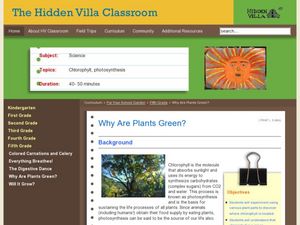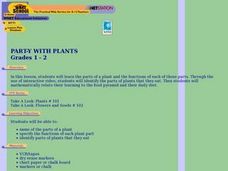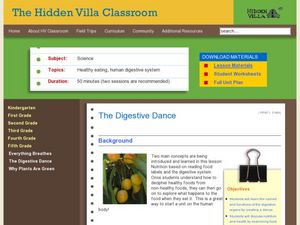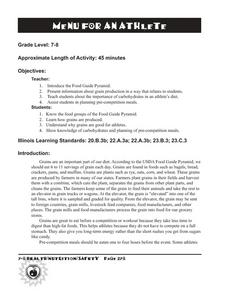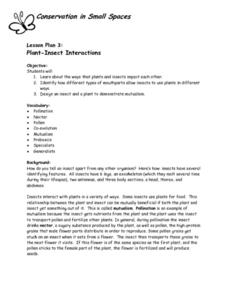Curated OER
Discovering Local Food Chains
Fourth graders study about food chains. With the assistance of a local biologist, Students hike the school trail system. They explore ecosystem and collect data by charting the organisms found and identifying the energy source. They...
Captain Planet Foundation
Energy Flow in the Garden
How can you tell what an owl has eaten? Study the food chain and flow of energy in an ecosystem by dissecting an owl pellet and noting the bones found inside. Additionally, the instructional activity includes a game about consumers and...
Curated OER
Links in a Food Chain
Little ones make costumes and act out a rhyme in which there are daisies, bugs, wrens, snakes, and foxes that all interact in a food web. This would be a memorable activity for primary life scientists to participate in as a wrap-up...
Curated OER
Six Plant Parts
Students create a harvest burrito out of fruit, flowers, roots, stems, and more. In this plants lesson plan, students go out into the garden and identify the 6 plant parts.
Curated OER
Energy Flow and the Food Chain
Students complete discussions and worksheets about the Hawaiian food chain. In this food chain lesson plan, students research decomposers, consumers, and producers.
Curated OER
Why Are Plants Green?
Students smash plant parts and wait for visibility of chlorophyl to show why plants turn green. In this green plants lesson plan, students use acetone and filter paper for this experiment.
Curated OER
Learning About Plants- Flowers for a Special Occasion
Students explore the parts of plants and discover that plants need to grow. In this plant lesson, students discuss the parts of the plant and plant petunias. Students can share their plants with friends or families.
Curated OER
Activity 1: Please Pass the Energy, Food Webs in the Upper Ocean and Hydrothermal Vent Communities
Students create food webs for two different ocean communities. They are given cards showing organisms from the surface of the ocean. They arrange them in order of who eats whom. After this class activity, students create a food web for...
Curated OER
Food Chains
Fourth graders study food chains, producers, consumers, and decomposers. They play a food chain game and create food chain mobiles or posters. They take a nature hike around the school and observe various parts of a food chain.
Curated OER
Parts of the Flower and Pollination
Students review the parts of the plant and recognize the parts that are important for pollination. For this pollination lesson, students illustrate and label the parts of a flower. Students compare different types of flowers.
California Academy of Science
Plants: Hanging Tough
Learning about the rainforest can be more fun than you think. The class discusses vocabulary-in-context as they cut cardboard boxes, destined to become part of a rainforest model. Small groups of children color, cut, and construct...
Curated OER
Crops 2: What Plants Need to Grow
Students explore agriculture by participating in a plant growth activity. In this botany lesson plan, students discuss what types of plants grow in their local environment and what the plants need to survive. Students read assigned text...
Curated OER
Party with Plants
Students watch a video on plant parts and identify the function of plant parts. In this plants lesson plan, students identify the parts of plants they eat and relate it back to the food pyramid and perform math problems as they do this.
Curated OER
Forest Food Web Activity
Students gain knowledge of food webs and ecological interconnections in the forest, and place different life forms in their proper place in a food chain. Students appreciate the balance of nature and how humans are affected by extinct...
Curated OER
Food Chain Chant
Students memorize a poem using various reading strategies to reinforce the concept of the food chain and the terminology associated with it.
Curated OER
Milkweed Plants
Second graders view milkweed plants (or pictures). The describe the plant and discuss ways some butterflies use it as a food source. Students view four pictures of different phases of a milkweed plant's life cycle. They discuss the...
Curated OER
Producers and Consumers
Students make lists of producers and consumers and act as consumers that eat producers in a garden. In this producers and consumers lesson plan, students demonstrate a food chain by using a piece of yarn to connect all of them together.
Curated OER
What A Tangled Web We Weave
Learners of many ages discuss how all organisms rely on other organisms for their survival. They construct a food web and energy pyramids, and write an informative essay about the food web that they have designed.
Curated OER
The Digestive Dance
Young scholars read food labels to compare healthy verses non healthy food and then use diagrams to create a poster of the digestive system. In this food lesson plan, students move the food down the digestive track along the digestive...
Curated OER
Menu for an Athlete
Football, basketball, softball. What do these sports have in common? Athletes. Young scholars learn about and discuss the food pyramind, especially grains, with the thought that they will be planning a pre-competition meal and snack for...
Curated OER
Coral Polyp Party
Learners complete a project where they label the parts of a coral polyp and discuss the differences between plants and animals. Students use marshmallows, sprinkles, toothpicks, and more to label their coral polyp.
Curated OER
Creating a Pollinator Garden
Students build a pollination garden. In this pollination instructional activity, students read directions and build a pollinator garden that will produce flowering plants for pollinator organisms to use in pollination of other plants.
Curated OER
Conservation in Small Spaces: Plant-Insect Interactions
Learners explore ways that plants and insects impact each other, identify how different types of mouthparts allow insects to use plants in different ways, and design an insect and a plant to demonstrate mutualism.
Curated OER
Rice Plants
Second graders investigate what plant is closely related to to rice. In this rice farming lesson, 2nd graders dicover the parts of rice and that rice is closely related to grass. Students create a rice picture and write sentences...





